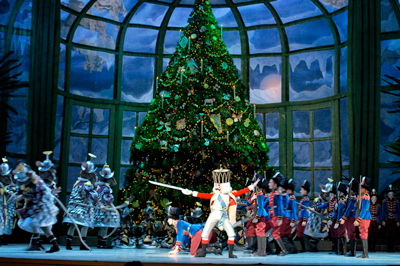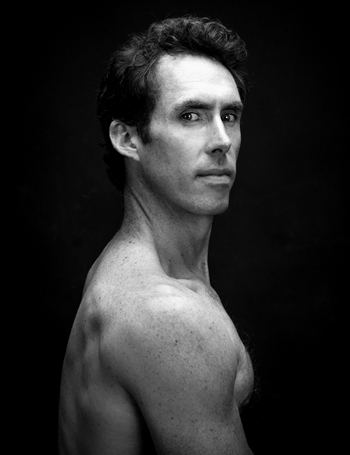by Mike Telin

Alexander Dumas’ libretto was criticized by some for being unfaithful to its source, E.T.A. Hoffmann’s tale The Nutcracker and the Mouse King. Some critics questioned the ballet’s prominent use of children, while others referred to the party scene as “ponderous” and to the Grand Pas de Deux as “insipid.”
Although the San Francisco Ballet produced the first complete Nutcracker in the United States in 1944, it was Russian-born choreographer George Balanchine’s production, premiered at City Center in New York on February 2, 1954, that is credited with making this holiday classic famous in the U.S.
Next week, The Cleveland Orchestra and Philadelphia’s Pennsylvania Ballet will join forces for seven performances of George Balanchine’s The Nutcracker at the State Theatre in Playhouse Square beginning on Wednesday, November 30 at 7:00 pm. Brett Mitchell conducts these rare, full-orchestra performances of Pyotr Tchaikovsky’s delectable musical confection, which include the Cleveland Orchestra Children’s Chorus. Visit our concert listings page for additional performance dates and times.
“I think the reason Nutcracker has become such a classic is that Balanchine was a genius choreographer,” Pennsylvania Ballet soloist James Ihde (pronounced EYED) said during a recent telephone conversation. “His Snow Scene and Waltz of the Flowers, in my opinion, are the best you’re going to find, both for their musicality and originality. The final pas de deux with Sugar Plum and Cavalier is beautiful. The entire production has all the magic and splendor that you would want.”
Ihde noted that Balanchine recreated it from his memories of seeing it as a child. “He also helped to disseminate it throughout America. Maybe that’s why his production has become so iconic, and one of the first in America that was performed on a regular basis.” The Balanchine production has been produced in New York every year since its premiere, and Pennsylvania Ballet has been staging it since the 1980s. “This is the version I am most familiar with,” Ihde said. “I see it as what Nutcracker looks like.”
A native of Kent, Ohio, James Ihde joined Pennsylvania Ballet as an Apprentice in 1993. Two years later he joined the company’s Corps de Ballet, and in 2003 he was promoted to Soloist. How many performances of Nutcracker has he danced? “I don’t know how many shows I have actually done, but I have performed in it every year. I’ve never stepped out because of injury or anything like that, so at this point — many, many shows.”
During his tenure with the company Ihde has performed a number of different Nutcracker roles. “I’m a fairly tall guy. At this point I feel like I’ve done every part that is applicable for a tall dancer, so I’ve seen it from many different perspectives.” Those roles include a mouse, Spanish dancer, Mouse King, Mother Ginger, a Spanish lead, the host in the party scene, and Cavalier.
This year Ihde will return to the role of Drosselmeyer, which he performed for the first time last season. “That was the first time in at least a decade that I took a new role in the production, so it was exciting to have something new to learn and to be nervous about. It did make me think about who Drosselmeyer is, and about his motivation. That was a new and welcome challenge.”
Throughout his long career, Ihde has seen many different takes on the character, ranging from the light and playful to the creepy, almost sinister, all of which are effective. “My Drosselmeyer is more of a warm uncle, although he is an eccentric, that’s for sure.”
While growing up in Northeast Ohio, James Ihde trained for eight years at the Dance Institute of the University of Akron, a time he remembers fondly. “Gina Carol ran the school, and even though she didn’t teach, she was very influential. Inna Stabrova and Brenda Steiger were two of my early teachers, and Tom Smith, who still teaches at the University, was important to me as well.”
Ihde said the Institute, with the University students and the Ohio Ballet Company all housed in the same building, provided a great environment for young dancers. “When the Company was rehearsing you could go watch them, and that was practical inspiration. I always felt lucky that we had such a vibrant place to train versus being at a small school that is closed off from everything else. It made it much more exciting.”
Compared to most young dancers, Ihde said he did not attend a lot of summer programs. “I went through the Pennsylvania Ballet summer program, and that’s when I got offered a job. I was very lucky because it all kind of clicked and worked out, and to my surprise, I’ve been there ever since.”
Unlike many young dancers, he didn’t immediately feel that dancing was something he wanted to pursue as a career. “That’s the interesting thing,” he said. “From the moment I started taking ballet, I really liked it. I was happy to be there, and I was happy to put in the work. I wanted to improve and keep moving up all of the different levels, but it took me a while to decide that dancing was something that I would want to do professionally. Even then I thought I’d only do it for a few years. I was obviously very wrong. I feel very lucky to have done this for so long, and with a company that I love so much.”
Published on ClevelandClassical.com November 22, 2016.
Click here for a printable copy of this article




